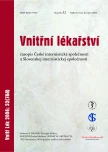Pathogenesis, diagnostics and therapy of gout
Authors:
M. Žurek
Authors‘ workplace:
III. interní klinika Lékařské fakulty UP a FN Olomouc, přednosta prof. MUDr. Vlastimil Ščudla, CSc.
Published in:
Vnitř Lék 2006; 52(7-8): 736-741
Category:
130th Internal Medicine Day - Rheumatology in clinical practice
Overview
Gout refers to heterogeneous group of metabolic diseases characterized by production of deposits of sodium urate crystals in tissues. Gout manifests as acute gouty arthritis with classic clinical picture, or as chronic gouty arthropathy with periarticular and subcutaneous deposits of sodium urate crystals, i.e. tophi. As for kidney, gout is manifested as acute or chronic gouty nephropathy and urolithiasis. These manifestations occur separately or they are combined. Hyperuricemia of primary gout is caused rather by impaired renal secretion than overproduction of uric acid. Secondary hyperuricemia is associated with many pathological conditions; it is also connected with the use of various medicaments. Pathogenesis of gouty arthritis is critically influenced by sodium urate crystals and inflammatory processes they induce. Hyperuricemia is part of metabolic syndrome X which is associated with unanswered question of the relationship between uric acid and atherosclerosis. Although gouty arthritis is the most frequent inflammatory disease of joints in men over 50 years of age, it is often diagnosed and treated inadequately. On that account, the indication of long-term hypouricemic therapy should be always based on the following criteria: secondary causes of hyperuricemia have to be excluded first; frequency of gout attacks and the risk of their recurrence should be taken into consideration; then it is necessary to search for renal manifestations of gout; and last but not least, we should check whether there are any associated diseases classified in metabolic syndrome X.
Key words:
gout – hyperuricemia – gouty arthritis – chronic tophaceous gout – asymptomatic hyperuricaemia – therapy of gout
Sources
1. Ghei M, Mihailescu M, Levinson J et al. Pathogenisis of hyperuricemia. Recent advances. Curr Rheumatol Rep 2002; 4: 270-274.
2. Campion EW, Glynn RJ, deLabry LO. Asymptomatic hyperuricemia: the risks and consequences. Am J Med 1987; 82: 421-426.
3. Hartus E, Budd R, Firestein G et al. Kelley's Textbook of Rheumatology. 7. ed. Místo vydání: WB Saunders 2004: 1402-1425.
4. Fam AG, Schumacher HR Jr, Clayburne G et al. A comparison of five preparations of synthetic monosodium urate monohydrate crystals. J Rheumatol 1992; 19: 780-787.
5. Stankovic A, Front P, Barbara A et al. Tophus-derived monosodium urate monohydrate crystals are biologically much more active than synthetic counterpart. Rheumatol Int 1991; 10: 221-226.
6. Chapman PT, Yarwood H, Harrison AA et al Endothelial activation in monosodium urate monohydrate crystal-induced inflammation: in vitro and in vivo studies on the roles of tumor necrosis factor alpha and interleukin-1. Arthritis Rheum 1977; 40: 955-965.
7. Roberge CJ, Brassi J, de Medicis R et al. Crystal-neutrophil interactions lead to interleukin-synthesis. Agents Actions 1994; 34: 38-41.
8. Tudan C, Fong D, Duronio V et al. The inhibition of spontaneous and tumor necrosis factor-α induced neutrophil apoptosis by crystals of calcium pyrophosphate dihydrate and monosodium urate monohydrate. J Rheumatol 2000; 27: 2463-2472.
9. Landis RC, Yagnik DR, Florey O et al. Safe disposal of inflammatory monosodium urate monohydrate crystals by differentiated macrophages. Arthritis Rheum 2002; 46: 3026-3033.
10. Kang DH, Nakagawa T, Feng L et al. A role for uric acid in the progression of renal disease. J Am Soc Nephrol 2002; 13: 2288-2297.
11. Culleton BF, Larson MG, Kannel WB et al. Serum uric acid and risk for cardiovascular disease and death: the Framingham Heart Study. Ann Intern Med 1999; 131: 7-13.
12. Bettencourt P, Ferreira A, Dias P et al. Predictors of prognosis in patients with stable mild to moderate heart failure. J Card Fail 2000; 6: 306-313.
13. Bigger JT, Heller CA, Wenger TL et al. Risk stratification after acute myocardial infarction. Am J Cardiol 1978; 42: 202-210.
14. Pavelka K. Is diagnosis and therapy of gout a simple matter? Vnitř Lék 1993; 39: 1073-1079.
15. Hochberg MC, Silman AJ, Smolen JS. Rheumatology. 3. ed. Doplnit místo vydání: Mosby 2003: 1920-1921.
16. Schlesinger N, Baker DG, Schumacher HR Jr. How well have diagnostic tests and therapies for gout been evaluated? Curr Opin Rheumatol 1999; 11: 441-445.
17. Fernandez C, Moguera R, Gonzalez JA et al. Treatment of acute attacks of gout with a small dose of intraarticular triameenalone acetonide. J Rheumatol 1999; 26: 2285-2286.
18. Iacobuzio-Donahue CA, Lee EL, Abraham SC et al. Colchicine toxicity. distinct morphologic findings in gastrointestinal biopsies. Am J Surg Path 2001; 25: 1067-1073.
19. Scott JT, Higgens CS. Diuretic induced gout: a multifactorial condition. Ann Rheum Dis 1992; 51: 259-261.
20. Eastmond CJ, Garton M, Robins S et al. The effects of alcoholic beverages on urate metabolism in gout sufferers. Br J Rheumatol 1995; 34: 756-759.
21. McCarthy GM, Barthelemy CR, Veum JA et al. Influence of antihyperuricemic therapy on the clinical and radiographic progression of gout. Arthritis Rheum 1991; 34: 1489-1494.
22. Yu TF. The efficacy of colchicine prophylaxis in articular gout - a reappraisal after 20 years. Semin Arthritis Rheum 1982; 12: 256-263.
23. Singer JZ, Wallace SL. The allopurinol hypersensitivity syndrome: unnecessary morbidity and mortality. Arthritis Rheum 1986; 29: 82-87.
24. Pavelka K. Dna (arthritis urica). In: Pavelka K, Rovenský J. Klinická revmatologie. Praha: Galén 2003: 447-458.
25. Pavelka K. Terapie dny. In: Pavelka K et al. Farmakoterapie revmatických onemocnění. Praha: Grada 2005: 349-350.
Labels
Diabetology Endocrinology Internal medicineArticle was published in
Internal Medicine

2006 Issue 7-8
Most read in this issue
- Nonsteroidal antiinflammatory drugs and the kidney
- Systemic lupus erythematodes
- Ankylosing spondylitis – the current situation and new therapeutic options
- Antiphospholipid syndrome
